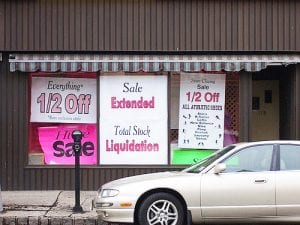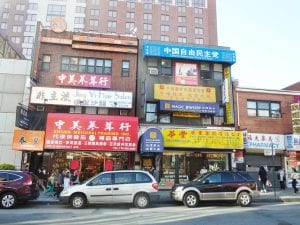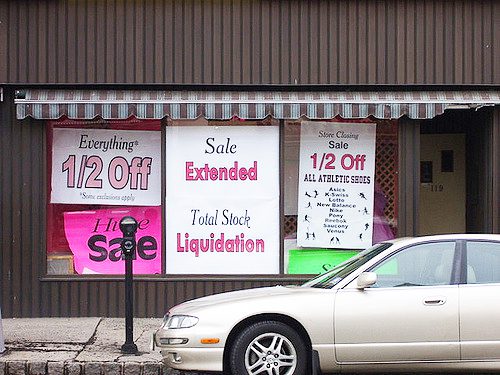
Photo by Victor Reynolds via flickr, CC BY-NC-ND 2.0
If you find yourself in New York in 2018, you’ll walk down the streets of a bustling metropolis, replete with glass-sided high-rises. Look deeper into the city’s neighborhoods, however, and you’ll see something else: signs signaling the end of an era for many businesses.
New York City’s small businesses, like small businesses in cities across the nation, are in the midst of a displacement crisis. And among the most affected are long-operating small businesses, especially those owned and operated by immigrants and people of color in low- and moderate-income neighborhoods.
While planning decisions have been known to change the physical landscape of a neighborhood, they rarely take into account their impact on the culture of a community. When a new office building rises or when a neighborhood is rezoned, planners are trained to think about changes in a community’s housing stock or infrastructure, but rarely about the daily lives of its residents. What happens to immigrant communities, communities of color, queer communities, artists, and organic neighborhood networks when the physical landscape of a neighborhood shifts under the influx of capital and new development?
Fifty-one percent of New York City’s small businesses are immigrant-owned, and in some neighborhoods, they employ up to 42 percent of the neighborhood population. When they disappear, not only does their loss change the physical character of a neighborhood, it equals the loss of employment, a driver of local economy, a place to purchase culturally relevant goods and services, and the very identity of that community. Their displacement or erasure erodes the fabric of neighborhoods and communities.
Many of these small businesses aren’t just a place to buy a quick breakfast or get a pair of shoes resoled; they also function as gathering sites—de facto town halls where politics ranging from the hyper-local to the international are discussed and analyzed. They are also places that provide a human connection to a transactional practice. What happens, for example, when the bodega that provides a young parent with food on credit closes?
The mechanisms around small business displacement are similar to those that cause residential displacement, as the same market forces are at play. Gentrification, landlord harassment, increases in rent, and intentional long-term vacancies are all common practices that lead to commercial tenants being priced out or forced out of the properties they occupy. However, little tracking or assessing of commercial displacement has been done to measure the impact the loss of small businesses has on communities.
The Association for Neighborhood and Housing Development (ANHD) analyzed the economic vitality of small businesses across New York City by neighborhood. Since there isn’t a clear, status quo definition of small business, nor comprehensive data on small businesses, we used New York City Department of Consumer Affairs (DCA) license expiration data to track how many total businesses, regardless of size, have expired licenses (in effect going permanently out of business) from 2011 through 2016, and quantified small businesses as those with 50 employees or less. The findings were eye-opening.
Overall, the city saw a 25 percent net increase in total business creation between 2011 and 2016, but net change varied widely by neighborhood. Though new growth is good, the context of that growth should be kept in mind—what was replaced, and with what? Some low- and moderate-income communities of color and immigrant communities, such as Sunset Park, which saw a net gain in business growth, also had among the highest rates of expirations of existing businesses in the city.

Flushing, Queens. Photo by All-Nite Images via flickr, CC BY-SA 2.0
The immigrant enclave of Flushing, which had among the greatest growth in business licenses, also saw 4.7 percent of existing business licenses expire in the period between 2011 and 2016. This means that though there was an increase in growth of new businesses, existing businesses closed at double the rate of the citywide average of total expirations, which was 2 percent. As New York’s neighborhoods change, and as immigrant communities and communities of color bear the brunt of displacement, advocates need to ensure that longstanding neighborhood institutions have the necessary support and opportunities to survive and thrive.
Though this analysis provides a cursory overview of New York’s small business landscape citywide, data on small firms is limited. Census level data relies on local, state, and federal administrative sources and does not capture unlicensed businesses, which tend to be located in the city’s most vulnerable commercial corridors. Additionally, little information exists to capture businesses using lending products outside of traditional bank loans.
Almost half of all New York City small businesses are immigrant-owned, but virtually nothing is known about their ability to access financing to start, maintain, and grow their businesses. As a result, though this analysis is broad, it is possible that the communities with the most pressing needs are underrepresented. In order to provide meaningful, strong protections and equitable access to resources for all of New York’s small businesses, better business data is crucial.
As advocates working toward more equitable communities, it’s crucial that our strategies to create an equitable city are based on a holistic vision of community. Growth of new business is a sign of a robust economy, but New York City’s true success hinges on ensuring that all of its residents have access to opportunity and community resources. In order to create truly equitable economic development, New York City’s small businesses must be protected, especially those owned and operated by immigrants and people of color.






Comments